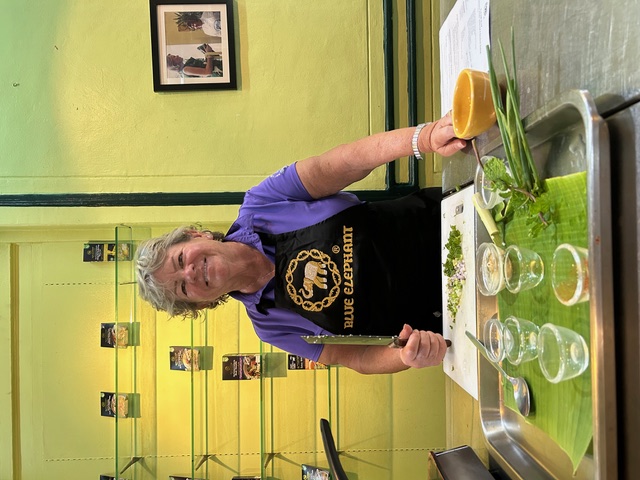
“Have you eaten yet?” This common salutation among Thai people (Gin Khao Reu Yang) reflects importance of food to their diet and culture. Indeed, food is taken so seriously in Thailand that kings have written odes to curries. Once you’ve tasted the real thing, you will forever crave the complex and mystical mélange.
Like the culture itself, Thai food is the product of various ethnic influences, including Chinese, Indian, Malaysian, Vietnamese, Cambodian and European.
According to CNN Travel’s World’s Best Food List (April 2021), Thai cuisine tops the list with three perennial favourites—papaya salad, shrimp soup and Massaman curry.
As much as I love eating Thai food, the idea of preparing a meal had always been a bit daunting. So, on my last trip to Bangkok, I packed a voracious appetite and enrolled in two hands-on cooking classes.
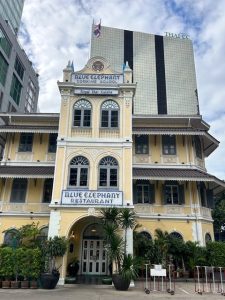 Blue Elephant Cooking School & Restaurant
Blue Elephant Cooking School & Restaurant
Chef Nooror Somany Steppe opened the Blue Elephant Cooking School & Restaurant in Bangkok in 2002. Named one of Thailand’s top chefs, Nooror has become an ambassador advocating Thai cuisine and culture worldwide. Her motto? “You cannot make good Thai food without good Thai ingredients!”
We met our teacher, Chef Chay, at the impressive century-old colonial mansion. From there we took the MRT subway to a nearby wet market—a feast for the senses. Pyramids of different coloured curry pastes, bundles of lemongrass, Thai garlic and basil, galangal, kaffir limes and freshly harvested morning glory leaves tempted. The variety of tropical fruits was remarkable: stinky durian, spiky rambutans, green mangos and my favourite, mangosteens.
We refreshed with some Thai iced coffee sweetened with condensed milk and made our way back to the mansion to prepare lunch.
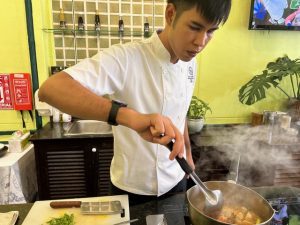 My fellow foodies were a couple of stylish men from France and a young gal from Germany who distained spicy food. Maybe she thought this experience would expand her culinary horizons! For each dish, chef demonstrated the steps in our classroom. We then moved next door to the main kitchen and worked at individual cooking stations, copying his technique.
My fellow foodies were a couple of stylish men from France and a young gal from Germany who distained spicy food. Maybe she thought this experience would expand her culinary horizons! For each dish, chef demonstrated the steps in our classroom. We then moved next door to the main kitchen and worked at individual cooking stations, copying his technique.
Cooking class menus change daily. Our dishes were Tom Yam Koong Mae Naam (hot and sour soup with river prawns), Kaeng Karee Nua (yellow beef curry), Laab Kai (minced chicken salad) and Phad Cha Plaa Kra Pong (stir-fried sea bass). We crushed coriander root, shallots and lemon grass for the aromatic soup. We pounded the myriad chilli spices for the Yellow Beef Curry with abandon. We created the spicy, sour, salty and sweet seasoning for the chicken salad using sugar, fish sauce, lime juice, chili and roasted rice powder. I realized that instead of “singing for my supper” I would be pounding as I smashed garlic, bird’s eye chili, shrimp paste with a mortar and pestle for the sea bass. At each step of the way chef Chay attentively supervised our progress.
Cooking completed, we received graduation certificates, packets of spices from the Blue Elephant gift shop and headed to the adjoining restaurant to enjoy the fantastic spectrum of flavours served with aromatic jasmine rice.
Morning and afternoon cooking classes take place every day but Sunday. Morning classes include a market visit. Maximum 20 people per class. www.blueelephantcookingschool.com
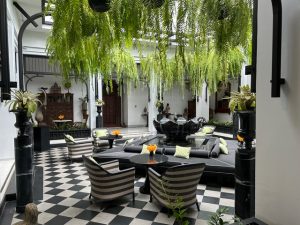 The Siam Cooking Class
The Siam Cooking Class
Arriving at The Siam hotel Siam (www.thesiamhotel.com) via the hotel’s vintage riverboat transported me into a unique and tranquil world onto its own in the middle of bustling Bangkok.
The Siam is the brainchild of Bangkok rock and movie star, Krissada Sukosol Clapp who built the hotel in 2012 as a retreat and place to house his and his mother’s vast collections of antique Thai treasures.
The Siam offers some unique guest experiences including having a Sak Yant ceremonial sacred tattoo, kick boxing lessons and Thai cooking classes. I opted for the latter joining chef Blair Mathieson, for a private lesson. We started our morning with a tuk-tuk ride with Uncle San, the Siam’s long time tuk-tuk chauffeur, to the local Thewet market. Live eels and frogs, pink eggs, a staggering variety of chilies, tropical fruit, dried and fresh shrimp and more beckoned. Chef bought coriander and basil for our class as we dodged shoppers on motor scooters.
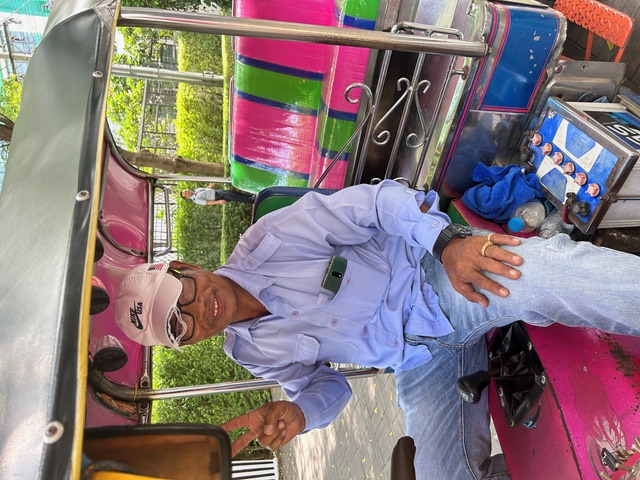
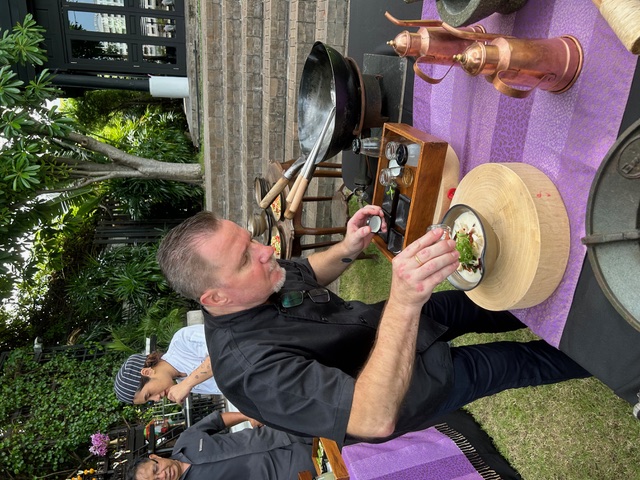
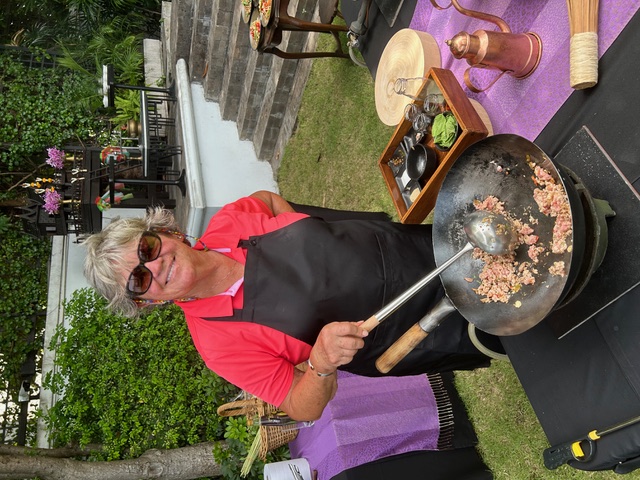
Back at the hotel we donned aprons at the alfresco cooking class on the lawn overlooking the Chao Phraya River and began to prepare my three-course lunch. Chef demonstrated how to tackle each of the recipes, from bruising lemongrass to tearing kaffir lime leaves. Then it was my turn. He also explained that Thai food contains five major flavours: sweet, sour, spicy, salty, bitter. Each dish should have a least two of those tastes and the key is getting the right balance. Hence the need to keep testing as you cook and add more chillies, more fish sauce, more coconut milk or more palm sugar as your palette dictates. First we made Som Tum (spicy/sour green papaya salad topped with roasted peanuts). Next was Tom Kha Gai soup (coconut milk broth with chicken, straw mushrooms topped with fresh coriander and drops of chilli oil). For our last dish, Gaeng Kiew Whan Goong (green prawn curry), chef taught me to make curry paste from scratch pounding the toasted coriander and cumin seeds, garlic, shallots, coriander roots, chillies, galangal and lemongrass with a mortar and pestle. Hard work but worth the effort. Each dish was brimming with complex flavours and textures, but I was amazed at how quickly they could be prepared. I enjoyed my three-course lunch in the hotel’s Chon Thai restaurant and washed it down with a lychee juice mocktail.
Reservations at least one day in advance are required. Maximum four people per class.
Thai Tricks
Mise en place, the French culinary phrase for “everything in its place” seems to be the most essential part of Thai cooking. At both schools, trays with precisely measured ingredients for each dish were prepared in advance for each student. The actual skill required to produce dishes didn’t involve a deft hand (such as required for rolling French pastry or Italian pasta) or the great knife skills of a sushi master. No, it’s more about having all the ingredients ready to go, using some elbow grease with the mortar and pestle and understanding the power of chilies.
Now, back home with a pantry stocked with fish sauce, an array of herbs and spices and some pre-packaged curry and shrimp pastes (sorry chefs), I have mastered some of the culinary wonders of the Kingdom.
A Few of my Best Bangkok Food Experience Paste
At the Michelin-starred Paste, chef Bee Satongun creates dishes based on ancient recipes that once delighted the royal family. Among the highlights of her delicious repertoire is a Thai crab omelette with 31 flavours.
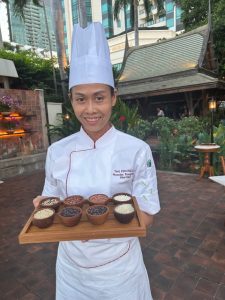 Thiptara Rice Journey
Thiptara Rice Journey
At the Peninsula Bangkok, enjoy the Thiptara Rice Journey at the hotel’s riverside Thai restaurant. Created by chef Monnipa Rungthong, the eight-course culinary voyage includes dishes that highlight the distinctive varieties of rice found throughout Thailand. You’ll begin with a rice cracker from Chiang Mai and end with a black rice dumpling made with “forget husband rice.” Legend has it that the glutinous bue loi khao klam rice from central Phetchabun province is so delicious that the wife cooking it will eat it all rather than saving some for her husband.
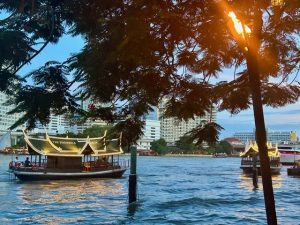
Chinatown Street Food
Yaowarat Road in Bangkok’s Chinatown is the place to snack on street food. Take the MRK to the Wat Mangkon station. Avoid Mondays as many vendors are closed. Pour a splash of chili sauce on the grilled squid. At T& K Seafood look for the waiters in green shirts and try the oyster omelette. Still hungry? Follow your nose and the lines.
Have you eaten yet?
